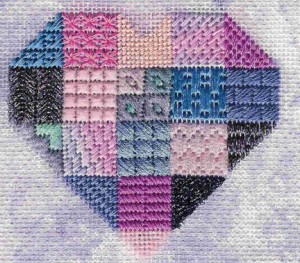
Often when we stitch needlepoint we function on automatic mode. We get a canvas and we start to stitch. It’s only after there are threads on the canvas that we start thinking of things we could have done that require coloring or manipulating the blank canvas.
Doing this cuts us all off from an exciting area of fiber arts called surface design. While mostly this is used in the quilting world many of these techniques can easily be applied to needlepoint canvases, whether commercially painted or not to create exciting backgrounds and effects that can have minimal or even no stitching.
What Is Surface Design?
Surface design is any technique used to change the ground fabric but just on the surface. If you dye your canvas, the color goes through the threads, it does not stay on the surface. Dyeing isn’t really a surface technique, although some kinds of dyeing are used in it.
But if you mask a portion of the canvas and paint around it — that’s keeping everything on the surface, so it would be considered surface design.
What Are Some Surface Design Techniques?
Although there are many,some of them work really well with needlepoint canvas. I’ve created canvases in the past using sponges, stamps, stencils, fabric, and colored pens. Other techniques on my list to try include colored pencils, color mixing with markers, and using foil and gold leaf.
Any of these can create a lovely background for your work. You may already know how to paint your canvas to avoid needlepoint dandruff but that’s covered by your stitching. For surface design to shine, it needs to be in the background and exposed.
In the next few months we’ll have an occasional series on surface design, showing you different techniques used on real canvases. We’ll start tomorrow with a discussion on sponge-painted backgrounds.
Are there general rules for surface design and needlepoint?
While there are many different techniques, some basic rules apply.
Most importantly do surface design before you start to stitch. No matter how careful you are, color can easily get onto your threads. Because most of these materials are permanent, they will color your threads.
If you are using fabric, avoid frayed edges that can be seen. Raw edges of fabric should be attached outside the stitching area, stabilized, or turned under. Raw edges ravel, you do not want that.
Decide if you will use a surface technique and where it will be used before you start to stitch. Take some time with your canvas and think about what you want to do. If you feel uncomfortable with a technique try it on a small freebie project first.
Many surface techniques can also be used in your main design. Stencils and stamps for example make great original needlepoints.
Join me as we explore these easy and inexpensive ways to make your needlepoint unique.
About Janet M Perry
Janet Perry is the Internet's leading authority on needlepoint. She designs, teaches and writes, getting raves from her fans for her innovative techniques, extensive knowledge and generous teaching style. A leading writer of stitch guides, she blogs here and lives on an island in the northeast corner of the SF Bay with her family

I so enjoy your discussions on needlepoint and this subject sounds very interesting. Since I don’t have a needlepoint store anywhere near me, it’s fun to find such a great online source for new techniques, ideas, etc. Thanks for all the hard work I know you put into this.
Thanks, you’ve made my morning.
Keep stitching,
Janet
I want to try this design on plastic canvas. Feel plastic canvas is a type of needle point. Thank you for a great idea